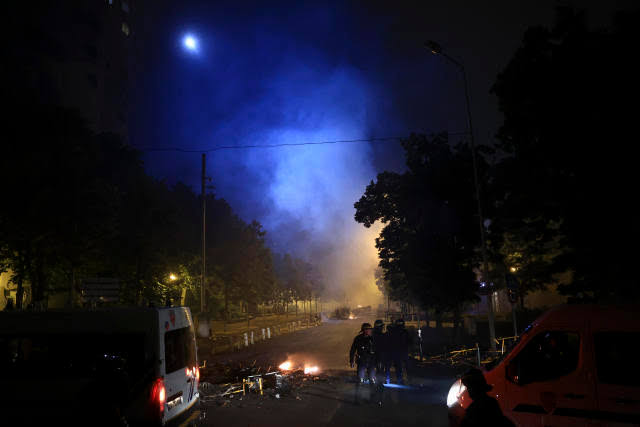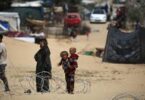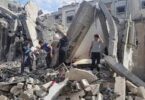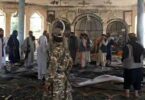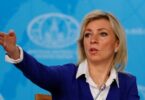NANTERRE (AP) : French protesters erected barricades, lit fires and shot fireworks at police in the streets of some French cities early Friday morning as tensions mounted over the deadly police shooting of a 17-year-old that has shocked the nation.
Armored police vehicles rammed through the charred remains of cars that had been flipped and set ablaze in the northwestern Paris suburb of Nanterre, where a police officer shot the teen who is only being identified by his first name, Nahel. On the other side of Paris, protesters lit a fire at the city hall of the suburb of Clichy-Sous-Bois.
In the Mediterranean port city of Marseille, police sought to disperse violent groups in the city center, regional authorities said.
Tens of thousands of police officers have been deployed to quell the protests, which have gripped the country three nights in a row. On Thursday, 100 people had been arrested by midnight, according to a national police spokesperson. The number was expected to rise as arrests underway were being tallied.
The police officer accused of pulling the trigger Tuesday was handed a preliminary charge of voluntary homicide after prosecutor Pascal Prache said his initial investigation led him to conclude “the conditions for the legal use of the weapon were not met.”
The detained police officer’s lawyer, speaking on French TV channel BFMTV, said the officer was sorry and “devastated.” The officer did what he thought was necessary in the moment, attorney Laurent-Franck Lienard told the news outlet.
“He doesn’t get up in the morning to kill people,” Lienard said of the officer, whose name has not been released. “He really didn’t want to kill. But now he must defend himself, as he’s the one who’s detained and sleeping in prison.”
Tensions started to rise in Nanterre following a peaceful march Thursday afternoon in honor of Nahel, with smoke billowing from cars and garbage bins set ablaze despite government appeals for calm and vows that order would be restored.
Interior Minister Gerald Darmanin said the number of officers in the streets would reach 40,000, with 5,000 deployed in the Paris region alone.
“The professionals of disorder must go home,” Darmanin said. While there’s no need yet to declare a state of emergency — a measure taken to quell weeks of rioting in 2005 — he added: “The state’s response will be extremely firm.”
Tensions had started to rise throughout Thursday.
In the usually tranquil Pyrenees town of Pau in southwestern France, a Molotov cocktail was thrown at a new police office, national police said. Vehicles were set on fire in Toulouse and a tramway train was torched in a suburb of Lyon, police said. Paris police said its officers made 40 arrests, some on the margins of the largely peaceful memorial march for the teen and others elsewhere.
Bus and tram services in the Paris area shut down before sunset as a precaution to safeguard transportation workers and passengers.
The town of Clamart, home to 54,000 people in the French capital’s southwest suburbs, said it was taking the extraordinary step of imposing an overnight curfew through Monday, citing “the risk of new public order disturbances.” The mayor of Neuilly-sur-Marne announced a similar curfew in that town in the eastern suburbs.
The unrest extended even to Brussels, the EU administrative home and Belgian capital city, where about a dozen people were detained during scuffles related to the shooting in France. Police spokeswoman Ilse Van de Keere said that several fires were brought under control and that at least one car was burned.
The shooting captured on video shocked France and stirred up long-simmering tensions between police and young people in housing projects and other disadvantaged neighborhoods.
The teenager’s family and their lawyers haven’t said the police shooting was race-related and they didn’t release his surname or details about him.
Still, anti-racism activists renewed their complaints about police behavior.
“We have to go beyond saying that things need to calm down,” said Dominique Sopo, head of the campaign group SOS Racisme. “The issue here is how do we make it so that we have a police force that when they see Blacks and Arabs, don’t tend to shout at them, use racist terms against them and in some cases, shoot them in the head.”
Prache, the Nanterre prosecutor, said officers tried to stop Nahel because he looked so young and was driving a Mercedes with Polish license plates in a bus lane. He allegedly ran a red light to avoid being stopped then got stuck in traffic. Both officers involved said they drew their guns to prevent him from fleeing.
The officer who fired a single shot said he feared he and his colleague or someone else could be hit by the car, according to Prache. The officers said they felt “threatened” as the car drove off.
He said two magistrates are leading the investigation, as is common in France. Preliminary charges mean investigating judges strongly suspect wrongdoing but need to investigate more before sending the case to trial.
On Wednesday night, as violence raged in the streets for a second night, protesters shot fireworks and hurled stones at police in Nanterre, who fired repeated volleys of tear gas.
As demonstrations spread to other towns, police and firefighters struggled to contain protesters and extinguish blazes. Schools, police stations, town halls and other public buildings were damaged from Toulouse in the south to Lille in the north, with most of the damage in the Paris suburbs, according to a national police spokesperson.
Fire damaged the town hall in the Paris suburb of L’Ile-Saint-Denis, not far from the country’s national stadium and the headquarters of the Paris 2024 Olympics.
Darmanin said 170 officers had been injured in the unrest but none of the injuries was life-threatening. The number of civilians injured was not immediately released.
The scenes in France’s suburbs echoed 2005, when the deaths of 15-year-old Bouna Traoré and 17-year-old Zyed Benna led to three weeks of riots, exposing anger and resentment in neglected, crime-ridden suburban housing projects. The two boys were electrocuted after hiding from police in a power substation in the Paris suburb of Clichy-sous-Bois.
French President Emmanuel Macron held an emergency security meeting Thursday about the violence.
“These acts are totally unjustifiable,” Macron said at the beginning of the meeting, which aimed at securing hot spots and planning for the coming days “so full peace can return.”
Deadly use of firearms is less common in France than in the United States, though several people have died or sustained injuries at the hands of French police in recent years, prompting demands for more accountability. France also saw protests against racial profiling and other injustice in the wake of George Floyd’s killing by police in Minnesota.
A police spokesperson said 13 people who didn’t comply with traffic stops were fatally shot by police last year. This year, three people, including Nahel, have died in similar circumstances.

